Page 302 of 473
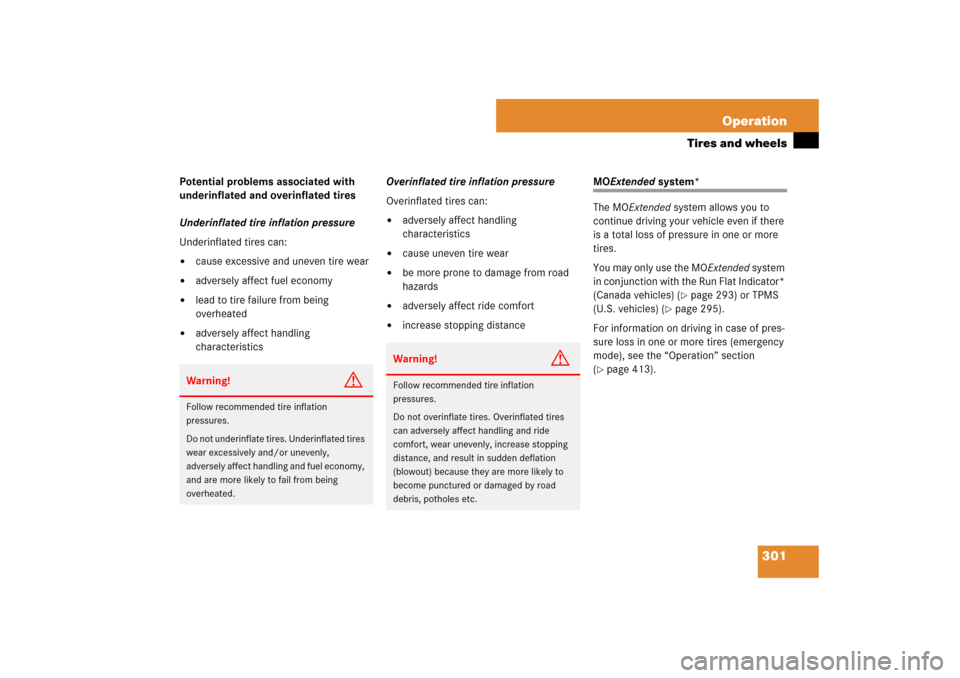
301 Operation
Tires and wheels
Potential problems associated with
underinflated and overinflated tires
Underinflated tire inflation pressure
Underinflated tires can:�
cause excessive and uneven tire wear
�
adversely affect fuel economy
�
lead to tire failure from being
overheated
�
adversely affect handling
characteristicsOverinflated tire inflation pressure
Overinflated tires can:
�
adversely affect handling
characteristics
�
cause uneven tire wear
�
be more prone to damage from road
hazards
�
adversely affect ride comfort
�
increase stopping distance
MOExtended system*
The MOExtended system allows you to
continue driving your vehicle even if there
is a total loss of pressure in one or more
tires.
You may only use the MOExtended system
in conjunction with the Run Flat Indicator*
(Canada vehicles) (
�page 293) or TPMS
(U.S. vehicles) (
�page 295).
For information on driving in case of pres-
sure loss in one or more tires (emergency
mode), see the “Operation” section
(
�page 413).
Warning!
G
Follow recommended tire inflation
pressures.
Do not underinflate tires. Underinflated tires
wear excessively and/or unevenly,
adversely affect handling and fuel economy,
and are more likely to fail from being
overheated.
Warning!
G
Follow recommended tire inflation
pressures.
Do not overinflate tires. Overinflated tires
can adversely affect handling and ride
comfort, wear unevenly, increase stopping
distance, and result in sudden deflation
(blowout) because they are more likely to
become punctured or damaged by road
debris, potholes etc.
Page 344 of 473
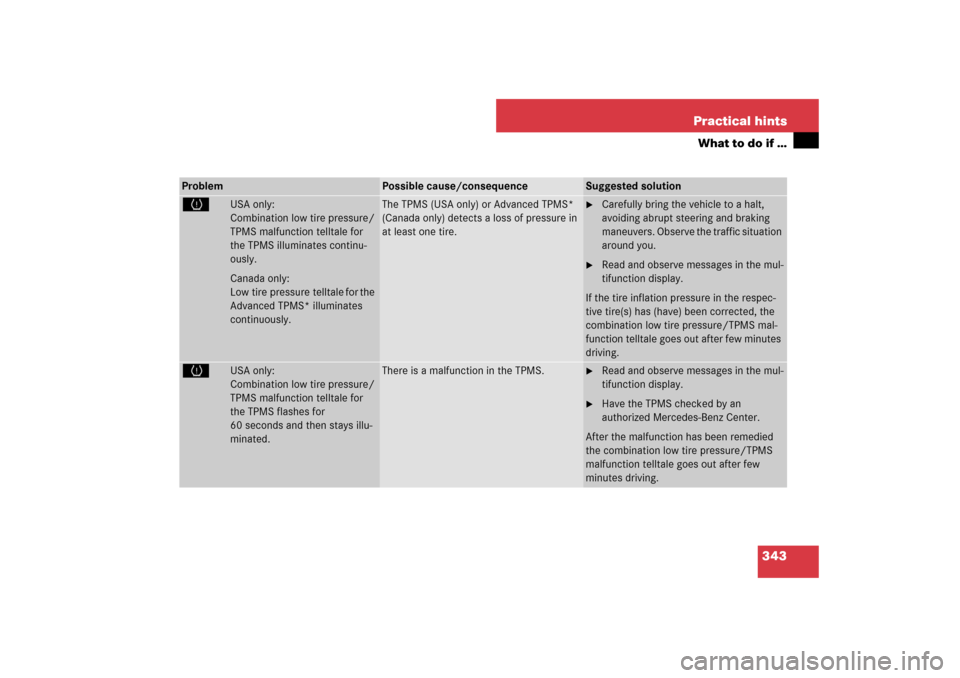
343 Practical hints
What to do if …
Problem
Possible cause/consequence
Suggested solution
H
USA only:
Combination low tire pressure/
TPMS malfunction telltale for
the TPMS illuminates continu-
ously.
Canada only:
Low tire pressure telltale for the
Advanced TPMS* illuminates
continuously.
The TPMS (USA only) or Advanced TPMS*
(Canada only) detects a loss of pressure in
at least one tire.
�
Carefully bring the vehicle to a halt,
avoiding abrupt steering and braking
maneuvers. Observe the traffic situation
around you.
�
Read and observe messages in the mul-
tifunction display.
If the tire inflation pressure in the respec-
tive tire(s) has (have) been corrected, the
combination low tire pressure/TPMS mal-
function telltale goes out after few minutes
driving.
H
USA only:
Combination low tire pressure/
TPMS malfunction telltale for
the TPMS flashes for
60 seconds and then stays illu-
minated.
There is a malfunction in the TPMS.
�
Read and observe messages in the mul-
tifunction display.
�
Have the TPMS checked by an
authorized Mercedes-Benz Center.
After the malfunction has been remedied
the combination low tire pressure/TPMS
malfunction telltale goes out after few
minutes driving.
Page 345 of 473
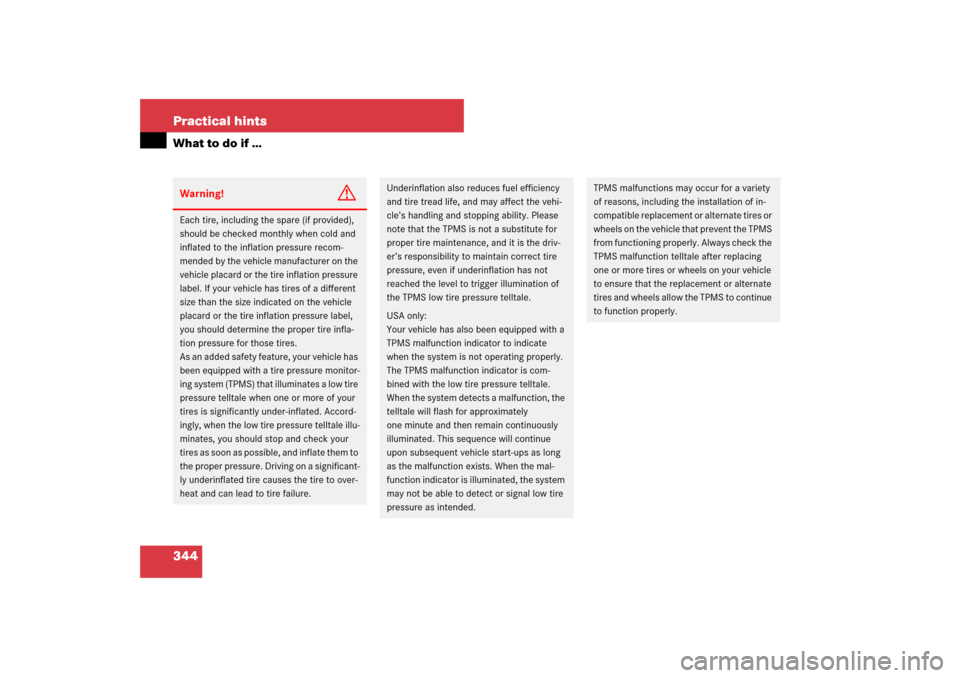
344 Practical hintsWhat to do if …Warning!
G
Each tire, including the spare (if provided),
should be checked monthly when cold and
inflated to the inflation pressure recom-
mended by the vehicle manufacturer on the
vehicle placard or the tire inflation pressure
label. If your vehicle has tires of a different
size than the size indicated on the vehicle
placard or the tire inflation pressure label,
you should determine the proper tire infla-
tion pressure for those tires.
As an added safety feature, your vehicle has
been equipped with a tire pressure monitor-
ing system (TPMS) that illuminates a low tire
pressure telltale when one or more of your
tires is significantly under-inflated. Accord-
ingly, when the low tire pressure telltale illu-
minates, you should stop and check your
tires as soon as possible, and inflate them to
the proper pressure. Driving on a significant-
ly underinflated tire causes the tire to over-
heat and can lead to tire failure.
Underinflation also reduces fuel efficiency
and tire tread life, and may affect the vehi-
cle’s handling and stopping ability. Please
note that the TPMS is not a substitute for
proper tire maintenance, and it is the driv-
er’s responsibility to maintain correct tire
pressure, even if underinflation has not
reached the level to trigger illumination of
the TPMS low tire pressure telltale.
USA only:
Your vehicle has also been equipped with a
TPMS malfunction indicator to indicate
when the system is not operating properly.
The TPMS malfunction indicator is com-
bined with the low tire pressure telltale.
When the system detects a malfunction, the
telltale will flash for approximately
one minute and then remain continuously
illuminated. This sequence will continue
upon subsequent vehicle start-ups as long
as the malfunction exists. When the mal-
function indicator is illuminated, the system
may not be able to detect or signal low tire
pressure as intended.
TPMS malfunctions may occur for a variety
of reasons, including the installation of in-
compatible replacement or alternate tires or
wheels on the vehicle that prevent the TPMS
from functioning properly. Always check the
TPMS malfunction telltale after replacing
one or more tires or wheels on your vehicle
to ensure that the replacement or alternate
tires and wheels allow the TPMS to continue
to function properly.
Page 364 of 473
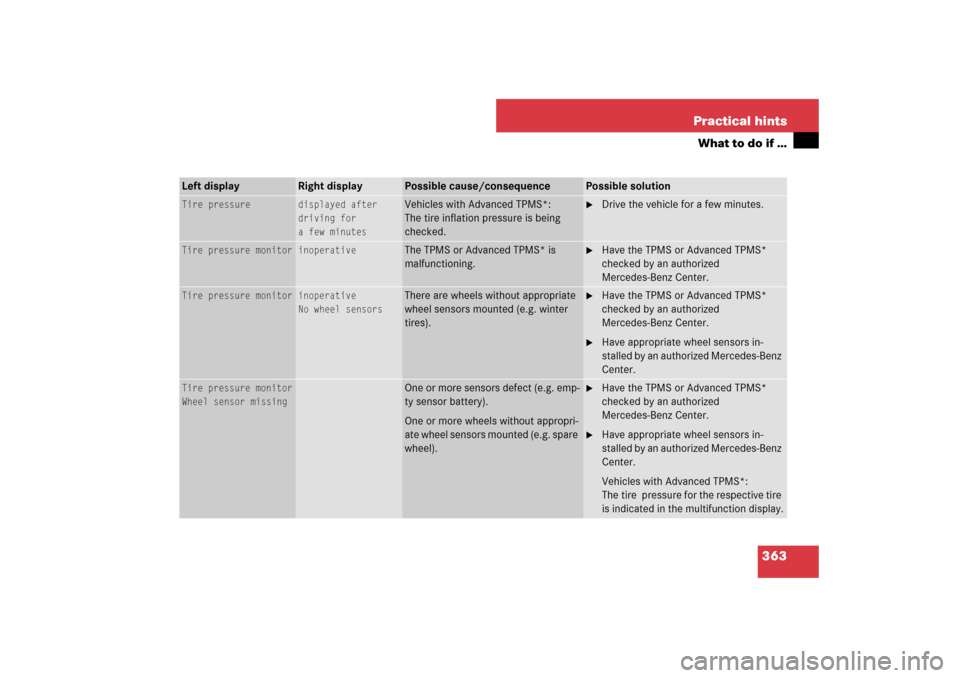
363 Practical hints
What to do if …
Left display
Right display
Possible cause/consequence
Possible solution
Tire pressure
displayed after
driving for
a few minutes
Vehicles with Advanced TPMS*:
The tire inflation pressure is being
checked.
�
Drive the vehicle for a few minutes.
Tire pressure monitor
inoperative
The TPMS or Advanced TPMS* is
malfunctioning.
�
Have the TPMS or Advanced TPMS*
checked by an authorized
Mercedes-Benz Center.
Tire pressure monitor
inoperative
No wheel sensors
There are wheels without appropriate
wheel sensors mounted (e.g. winter
tires).
�
Have the TPMS or Advanced TPMS*
checked by an authorized
Mercedes-Benz Center.
�
Have appropriate wheel sensors in-
stalled by an authorized Mercedes-Benz
Center.
Tire pressure monitor
Wheel sensor missing
One or more sensors defect (e.g. emp-
ty sensor battery).
One or more wheels without appropri-
ate wheel sensors mounted (e.g. spare
wheel).
�
Have the TPMS or Advanced TPMS*
checked by an authorized
Mercedes-Benz Center.
�
Have appropriate wheel sensors in-
stalled by an authorized Mercedes-Benz
Center.
Vehicles with Advanced TPMS*:
The tire pressure for the respective tire
is indicated in the multifunction display.
Page 365 of 473
364 Practical hintsWhat to do if …Left display
Right display
Possible cause/consequence
Possible solution
Tire pressure monitor
currently
unavailable
The TPMS or Advanced TPMS* is
unable to monitor the tire pres-
sure due to�
a nearby radio interference
source.
�
excessive wheel sensor tem-
peratures.
As soon as the causes for the malfunction are
no longer present, the TPMS or Advanced
TPMS* automatically becomes active again
after a few minutes driving.
Warning!
G
Do not drive with a flat tire. A flat tire affects
the ability to steer or brake the vehicle.
You may lose control of the vehicle. Contin-
ued driving with a flat tire will cause exces-
sive heat build-up and possibly a fire.
Page 386 of 473
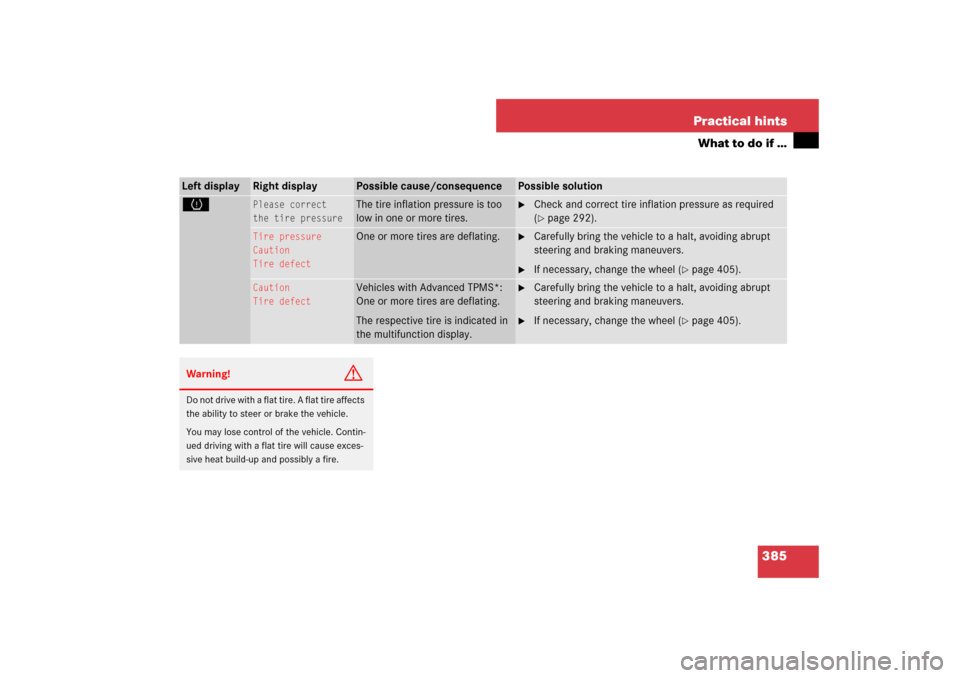
385 Practical hints
What to do if …
Left display
Right display
Possible cause/consequence
Possible solution
H
Please correct
the tire pressure
The tire inflation pressure is too
low in one or more tires.
�
Check and correct tire inflation pressure as required
(�page 292).
Tire pressure
Caution
Tire defect
One or more tires are deflating.
�
Carefully bring the vehicle to a halt, avoiding abrupt
steering and braking maneuvers.
�
If necessary, change the wheel (
�page 405).
Caution
Tire defect
Vehicles with Advanced TPMS*:
One or more tires are deflating.
The respective tire is indicated in
the multifunction display.
�
Carefully bring the vehicle to a halt, avoiding abrupt
steering and braking maneuvers.
�
If necessary, change the wheel (
�page 405).
Warning!
G
Do not drive with a flat tire. A flat tire affects
the ability to steer or brake the vehicle.
You may lose control of the vehicle. Contin-
ued driving with a flat tire will cause exces-
sive heat build-up and possibly a fire.
Page 387 of 473
386 Practical hintsWhat to do if …Left display
Right display
Possible cause/consequence
Possible solution
H
Tire pressure
Check tires
The tire pressure in one or more
tires is already below the mini-
mum value.
�
Carefully bring the vehicle to a halt, avoiding abrupt
steering and braking maneuvers.
�
Check and adjust tire pressure as required.
�
If necessary, change the wheel.
Check tires
Vehicles with Advanced TPMS*:
The tire pressure in one or more
tires is already below the mini-
mum value.
The respective tire is indicated in
the multifunction display.
�
Carefully bring the vehicle to a halt, avoiding abrupt
steering and braking maneuvers.
�
Check and adjust tire pressure as required.
�
If necessary, change the wheel.
Warning!
G
Do not drive with a flat tire. A flat tire affects
the ability to steer or brake the vehicle.
You may lose control of the vehicle. Contin-
ued driving with a flat tire will cause exces-
sive heat build-up and possibly a fire.
Page 413 of 473
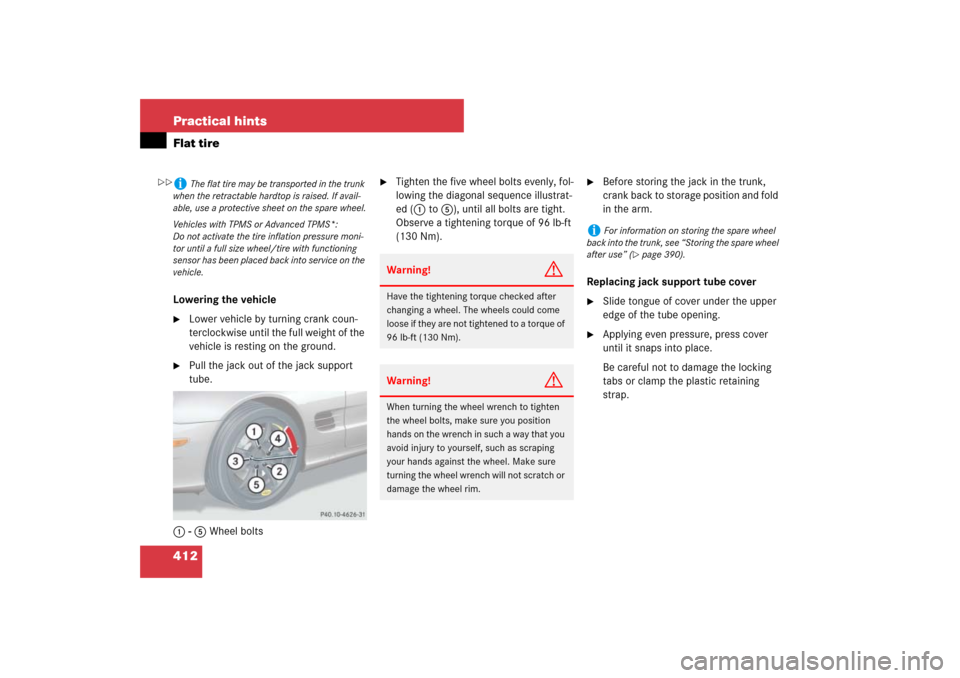
412 Practical hintsFlat tireLowering the vehicle�
Lower vehicle by turning crank coun-
terclockwise until the full weight of the
vehicle is resting on the ground.
�
Pull the jack out of the jack support
tube.
1 - 5 Wheel bolts
�
Tighten the five wheel bolts evenly, fol-
lowing the diagonal sequence illustrat-
ed (1 to 5), until all bolts are tight.
Observe a tightening torque of 96 lb-ft
(130 Nm).
�
Before storing the jack in the trunk,
crank back to storage position and fold
in the arm.
Replacing jack support tube cover
�
Slide tongue of cover under the upper
edge of the tube opening.
�
Applying even pressure, press cover
until it snaps into place.
Be careful not to damage the locking
tabs or clamp the plastic retaining
strap.
i
The flat tire may be transported in the trunk
when the retractable hardtop is raised. If avail-
able, use a protective sheet on the spare wheel.
Vehicles with TPMS or Advanced TPMS*:
Do not activate the tire inflation pressure moni-
tor until a full size wheel/tire with functioning
sensor has been placed back into service on the
vehicle.
Warning!
G
Have the tightening torque checked after
changing a wheel. The wheels could come
loose if they are not tightened to a torque of
96 lb-ft (130 Nm).Warning!
G
When turning the wheel wrench to tighten
the wheel bolts, make sure you position
hands on the wrench in such a way that you
avoid injury to yourself, such as scraping
your hands against the wheel. Make sure
turning the wheel wrench will not scratch or
damage the wheel rim.
i
For information on storing the spare wheel
back into the trunk, see “Storing the spare wheel
after use” (
�page 390).
��